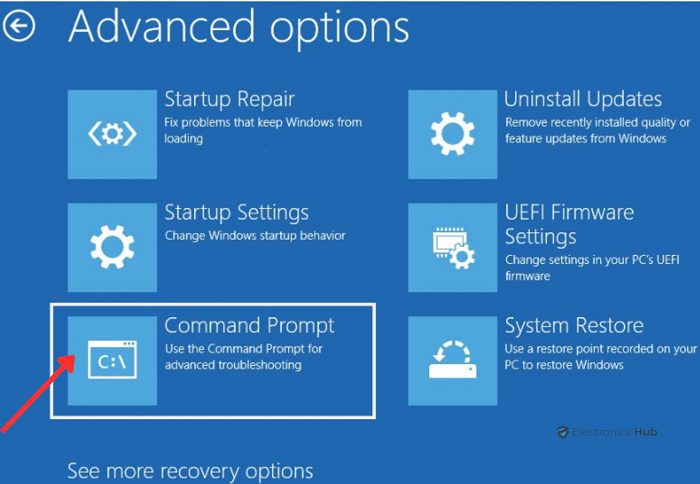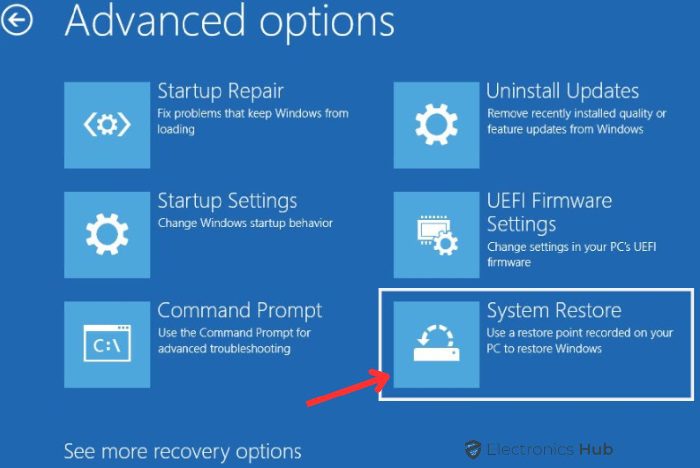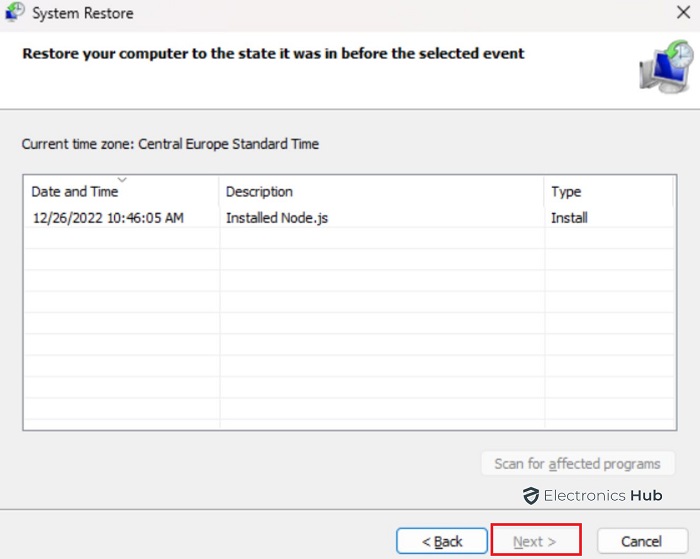By now, Microsoft has made its Windows operating system pretty much bulletproof thanks to regular updates over the years. That being said, you can still sometimes face issues and errors on your computer. And the worst type of errors you can face on a Windows PC are BSOD errors which essentially crash your computer leading to potential data loss and even system corruption.
As a result, getting rid of any BSOD error like the “Bad System Config Info” BSOD error discussed here is highly important. Hence, if you are also facing the “Bad System Config Info” BSOD error, then make sure to go through this guide till the end to fix the same.
Outline
Toggle- What is the Bad System Config Info BSOD Error?
- Causes of the Bad System Config Info BSOD Error
- How to Fix the Bad System Config Info BSOD Error?
- Restart your PC
- Use DISM or Deployment Image Servicing and Management Tool
- Use SFC or System File Checker
- Run the CHKDSK or Check Disk Tool
- Check for RAM and Hardware Faults
- Repair the BCD or Boot Configuration Data
- Edit the BCD or Boot Configuration Data
- Fix Windows System32 Files
- Uninstall Recent Windows Updates
- Use the System Restore Tool
- Install Windows Updates
- Install Device Driver Updates
- Factory Reset your PC
- FAQs
- Conclusion
What is the Bad System Config Info BSOD Error?
If you have faced a BSOD error for the first time or just want to know about it in detail, then you must want to learn more about the “Bad System Config Info” BSOD error. This type of BSOD error is one of the most common ones out there. It is generally caused when Windows is not able to complete multiple processes at once due to issues with the system configuration data and files. However, this BSOD error might not be directly connected to the system configuration data itself.
Causes of the Bad System Config Info BSOD Error
Even though the name itself suggests that the “Bad System Config Info” BSOD error is caused due to improper system configuration data and files, this error can also be caused due to other reasons. This is due to the reason that if any other error or issue on your computer restricts Windows from accessing the system configuration file or corrupts it, then you may face this BSOD error. Similarly, here are some other common causes of the “Bad System Config Info” BSOD error on Windows:
Incorrect Registry Configuration
As you would expect, the most common and obvious cause of the “Bad System Config Info” BSOD error is that the system registry configuration is corrupted or incorrect. If your computer has any incorrect registry configuration, then Windows may not work properly. This can then result in the “Bad System Config Info” BSOD error again and again.
Corrupted Windows System Files
Apart from having incorrect or corrupted system registry configuration, the Windows operating system of your computer itself may have corrupted system files. And as you would expect, if the Windows files are corrupted, then your computer won’t work properly which can cause the “Bad System Config Info” BSOD error.
Corrupted or Damaged RAM
Other than facing the “Bad System Config Info” BSOD error due to software or operating system issues, you can also face the same because of hardware failure. For example, if either the hard drive or the RAM of your computer stops working or gets damaged, then Windows won’t function properly resulting in the “Bad System Config Info” BSOD error.
Corrupted BCD or Boot Configuration Data
Whenever you turn on your computer, the BCD or the Boot Configuration Data file is responsible for loading up the operating system from your hard drive or SSD. Due to this, if the BCD itself is corrupted, then it may not load the Windows operating system correctly which is similar to having corrupted Windows system files on your computer. Thus, it can also lead to the “Bad System Config Info” BSOD error.
How to Fix the Bad System Config Info BSOD Error?
Since we have already covered the major causes of the “Bad System Config Info” BSOD error, you must have a fairly good idea of how you can get rid of this issue. However, if you are still confused, you can simply go through the following solutions one by one to fix the “Bad System Config Info” BSOD error:
Restart your PC
While it may sound quite simple and obvious, restarting your computer can fix a lot of issues and errors. Whenever you restart your computer, it gets rid of any temporary software issues and bugs which can even prevent BSOD errors in some cases. So, if you have been facing BSOD errors quite often, make sure to keep restarting your PC at least once a day.
Use DISM or Deployment Image Servicing and Management Tool
A great thing about Windows is that it offers various diagnosis and troubleshooting tools for fixing all sorts of errors and issues. One such tool happens to be the DISM or Deployment Image Servicing and Management Tool. This tool allows you to fix the Windows image or essentially the Windows system files to prevent BSOD errors as explained here:
- Start by opening the Command Prompt as an Administrator from the Start Menu.
- Here, type DISM /online /cleanup-image /restorehealth and press enter.
- Doing so will make Windows fix any issues with the Windows image which can lead to BSOD errors.
Use SFC or System File Checker
Another great way to fix broken or corrupted Windows system files is to use the SFC tool which stands for system file checker. Just per the name, SFC will check all Windows system files on your computer and get rid of any corrupted errors. As a result, you won’t face any BSOD errors from corrupted system files:
- First, launch Command Prompt as an Administrator on your computer.
- Then, type sfc /scannow and press enter. After this, all Windows system files will be checked and fixed to get rid of all BSOD errors from your PC.
Run the CHKDSK or Check Disk Tool
Other than having corrupted system files, it is also possible that Windows is not able to access the system files because of issues with the hard drive of your computer. Fortunately, you can check and fix such issues with your computer’s hard drive by using the CHKDSK or the Check Disk tool by following these steps:
- Go to the Start Menu on your PC and run Command Prompt as an Administrator.
- Now, type chkdsk /r and press enter to run the Check Disk tool.
- Once done, your computer will check and fix all issues with its hard drive to prevent BSOD errors.
Check for RAM and Hardware Faults
Apart from a hard drive failure, it is also possible to have faulty RAM and other hardware components inside your computer. In either case, it is highly important to ensure that all of the hardware components of your PC are installed correctly and functioning properly. For this, you need to open up your PC, recheck all connections, and confirm that there are no faulty parts inside.
Repair the BCD or Boot Configuration Data
Since the BCD or Boot Configuration Data is responsible for loading up Windows on your PC, any faults with the same can cause all sorts of errors in Windows including BSOD errors. Thus, you should repair the BCD or Boot Configuration Data of your PC as a precaution:
- You first need to make a bootable Windows USB flash drive using a tool like Windows Media Creation Tool or Rufus.
- Once you have a bootable Windows USB drive, insert it into your computer and turn it on.
- Now, select this USB drive as the boot device. Here, select Repair your computer.
- After that, go to Advanced Options under the Troubleshoot menu and open Command Prompt.
- Here, type out the following commands one by one followed by enter on your keyboard:
- bootrec /repairbcd
- bootrec /osscan
- bootrec /repairmbr
- Finally, close Command Prompt and restart your computer to repair the BCD or Boot Configuration Data file.
Edit the BCD or Boot Configuration Data
If you have repaired the BCD configuration of your PC but are still facing BSOD errors, then it is highly likely that you have selected incorrect options for the BCD. In that case, you need to edit the BCD or Boot Configuration Data using the advanced startup menu as explained here:
- Press Windows Key + I on your keyboard and go to the Recovery menu.
- Here, click on Restart Now next to the Advanced Startup option.
- Once your computer restarts, select Troubleshoot and open Advanced Options.
- Now, open Command Prompt and enter the following commands one by one along with Enter after each command:
- bcdedit/deletevalue {default} numproc
- bcdedit/deletevalue {default} truncatememory
- Lastly, restart your computer to save these edits to the BCD file.
Fix Windows System32 Files
You can also try manually fixing the Windows System32 files on your computer to fix the “Bad System Config Info” BSOD error. But since you can’t edit System32 files directly, you need to follow the given method:
- Start by inserting a bootable Windows flash drive in your computer and using it as the boot drive.
- Then, click on Repair your computer and open the Troubleshoot menu.
- Here, click on Advanced Options and launch Command Prompt.
- Once you are in Command prompt, you need to rename a few folders by running these commands one by one:
- CD C:WindowsSystem32config
- ren C:WindowsSystem32configDEFAULT DEFAULT.old
- ren C:WindowsSystem32configSAM SAM.old
- ren CWindowsSystem32configSECURITY SECURITY.old
- ren C:WindowsSystem32configSOFTWARE SOFTWARE.old
- ren C:WindowsSystem32configSYSTEM SYSTEM.old
- After that, you need to add new folders in Windows System32 by using the following commands one by one:
- copy C:WindowsSystem32configRegBackDEFAULT C:WindowsSystem32config
- copy C:WindowsSystem32configRegBackSAM C:WindowsSystem32config
- copy C:WindowsSystem32configRegBackSECURITY C:WindowsSystem32config
- copy C:WindowsSystem32configRegBackSYSTEM C:WindowsSystem32config
- copy C:WindowsSystem32configRegBackSOFTWARE C:WindowsSystem32config
- Lastly, close Command Prompt and restart your computer.
Uninstall Recent Windows Updates
Even though Windows Updates are meant to add new features and fix issues in your computer, they can sometimes add bugs to your PC as well. Thus, if you have been facing BSOD errors after a recent Windows update, then you need to uninstall recent Windows updates by following these steps:
- Head over to Windows Settings and click on Updates History under the Windows Update menu.
- After that, find and delete any recent update that will roll back your Windows to a previous version and fix any issues caused due to the same.
Use the System Restore Tool
If you don’t find any option to roll back to the previous version of Windows under the Windows Update settings, then you can try using the System Restore Tool as an alternative:
- First insert a bootable Windows flash drive in your computer and reboot your computer using the same.
- Now, click on Repair your computer and open the Troubleshoot menu.
- Finally, click on Advanced Options and select System Restore.
You can then follow the on screen instructions to roll back your computer to a previous date and an older version of Windows.
Install Windows Updates
On the other hand, if you have not installed any updates on your Windows PC for a long time, then you may be facing bugs because of that. Hence, you can try updating Windows on your PC by following these steps:
- Go to the Windows Settings on your PC and open the Windows Update menu.
- Now, click on the Check for Updates button to install new updates on your computer and fix any BSOD errors.
Install Device Driver Updates
Other than updating the Windows version on your computer, you also need to update all the device drivers. This can be easily done using the Device Manager:
- Press Windows Key + X on your keyboard to open up Device Manager.
- Now, right click on each device one by one and select Update Drivers.
- You can then automatically update all the device drivers on your computer to prevent BSOD errors.
Factory Reset your PC
As a last resort, you can also try resetting your PC if you have been facing the “Bad System Config Info” BSOD error quite often. This can be done using the Windows Recovery Environment as explained down below:
- Start by booting your computer using a bootable Windows flash drive.
- Then, click on Repair your computer and head over to the Troubleshoot menu.
- Here, select the Reset this PC option.
- You can then select the Keep my Files option to save all your data.
- And at last, click on the Reset button to reset your PC and fix the “Bad System Config Info” BSOD error.
FAQs
A. By now we have already covered all of the major fixes for the “Bad System Config Info” BSOD error. Out of all these, performing a system restore or using the Windows Recovery option are the two most effective ones to get rid of the “Bad System Config Info” BSOD error. Alternatively, you can also run a disk check to prevent the “Bad System Config Info” BSOD error.
A. Even though an error like the “Bad System Config Info” BSOD error is primarily related to major system issues, it can sometimes be caused due to third party apps or software as well. If you have a faulty app on your PC, then it can interfere with the system files resulting in the “Bad System Config Info” BSOD error.
A. Other than possible software issues, it is also possible to face the “Bad System Config Info” BSOD error due to hardware faults. It can be caused due to faulty RAM, a nonfunctional hard drive, or other faulty components inside your computer which can cause this issue.
A. If you have fixed the “Bad System Config Info” BSOD error and don’t want to face it again, then you need to opt for regular maintenance of your computer. This includes doing things like regularly updating your PC, keeping regular backups and system restore points, regularly updating device drivers, and avoiding all untrusted third party apps on your computer.
Conclusion
Whenever you face an issue or error on your computer, fixing it or working around it is fairly simple. However, things change drastically whenever you start facing BSOD errors on a regular basis. Since a BSOD error simply crashes your computer leading to potential data loss, fixing BSOD errors like the “Bad System Config Info” BSOD error is highly important. Thus, we have already given a complete guide on how to fix the “Bad System Config Info” BSOD error above in this article. And if this guide has also helped you with the same, then make sure to leave your thoughts and suggestions in the comments section down below.





